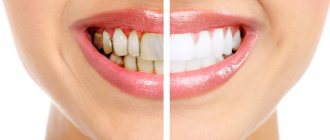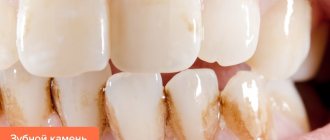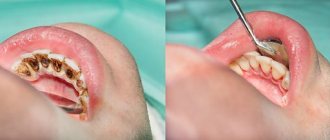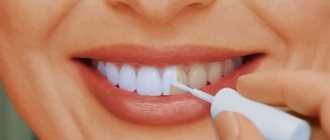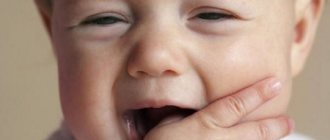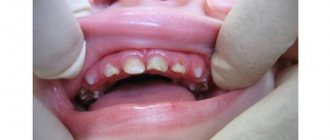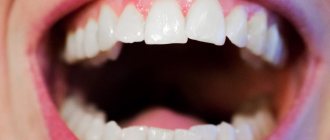The key to health is proper body care from childhood. This also applies to the oral cavity.
Parents should closely monitor the condition of the child's oral cavity. But sometimes, despite all efforts, proper care and a healthy diet, you may notice a deterioration in the condition of your teeth. A common problem is the presence of a yellow coating on them. Often parents consider this situation to pass and not require attention or treatment. And this is wrong! Yellow plaque on a child’s teeth can be either a symptom of problems in the body or an independent disease, which, if left untreated, can lead to various complications in the future.
Types of plaque
- White.
By the end of the day, all children have a small amount of harmless white residue. Abundant formation indicates vitamin deficiency, reduced immunity or insufficient hygiene. This type of plaque can be removed from a child’s teeth if you brush your teeth thoroughly every day. The presence of hard fruits and vegetables in the diet, such as apples and carrots, promotes mechanical cleaning. If no action is taken, the layer will harden, mineralize and turn into tartar.
- Yellow.
Indicates insufficient hygiene and poor nutrition. In children under two years of age, it can occur, for example, due to the consumption of sweet liquids from a bottle. It may also indicate the initial stage of caries. By choosing the right toothpaste and brush, as well as brushing your teeth more thoroughly, this problem can be solved.
- From light gray to green.
Gray - possible with abundant release of chlorophyll, sometimes acquires a greenish tint. Green - provoked by a fungus - chromogenic bacteria. Damages the pellicle, the natural protective film on the teeth. Only a dentist can help remove such plaque.
- Brown.
Indicates a fungal infection of the oral cavity and a disorder in the gastrointestinal tract. The result is darkening of the enamel. Iron supplements can also stain teeth brown. How to remove such plaque from a child’s teeth? Sometimes it goes away on its own after you stop taking iron-containing foods or medications. If the deposits have hardened, you will need professional teeth cleaning - ultrasound or chemical whitening. It is also necessary to adjust the child’s nutrition.
- Black.
Black plaque is the first harbinger of caries. Especially if it has a point character. In such cases, it is better not to postpone a visit to the dentist.
Causes of yellow teeth
Experts note that a child’s body, which is just beginning to function normally, is influenced by many negative external factors. Together they can lead to various disorders. Dentists identify a number of reasons why yellow plaque may form on a child’s teeth, namely:
- improper diet;
- drug treatment;
- insufficient hygiene;
- internal diseases;
- congenital problems;
- heredity.
If we talk about food, then the diet of both an adult and a child should be balanced. Of course, you cannot deprive your child of tasty but not very healthy foods, for example, sweets. But, nevertheless, fruits and vegetables, including raw ones, should prevail in the children's diet. In addition to the fact that they are rich in vitamins and minerals vital for the healthy and full development of the body, they also mechanically clean teeth of various plaque.
The less dyes, chemicals and sugar in food, the healthier and safer it is for the child. The more food is processed and far from its original state (convenience foods, sausages, sweets, flour products), the worse it affects teeth and gums.
Some antibiotics and other medications can stain teeth. Long-term use of medications carries the risk that the enamel may turn yellow. As a rule, after completing the course of treatment, the body cleans the teeth on its own. And after some time, the baby’s smile is snow-white again.
The next reason why yellow spots may appear on the teeth of a one-year-old child and older is improper oral hygiene. If you neglect it, a soft plaque may form on your baby’s teeth. It is this that gives the yellowish tint. In addition, it is a beneficial environment for the proliferation of various bacteria, which can lead to caries and other extremely unpleasant problems in the oral cavity.
If a child is not accustomed to brushing their teeth thoroughly and regularly, this will cause many problems in the future. One of the most important tasks of parents is to instill in their child the habit of constant care of their own oral cavity. The baby should be able to brush his teeth, know when to do it, and be familiar with the basic rules of oral hygiene from early childhood! And parents should unobtrusively control the process of brushing their teeth - perform this hygienic procedure together; make a habit of smiling after brushing your teeth to see if the baby has coped with the task assigned to him, etc.
Often yellowing of teeth signals internal problems in the body. For example, about problems with metabolism, disorders of the gastrointestinal tract or thyroid gland. If your teeth suddenly turn yellow, and this is not due to taking medications or poor nutrition, consult a doctor. He will identify the cause of yellowing of the enamel.
Often the reasons why a child’s chewing teeth or incisors are yellow are congenital. If you or your relatives have yellow tooth enamel, and this is not associated with disease or poor hygiene, the color may be hereditary.
Your baby’s teeth may turn yellow if, during pregnancy, the mother:
- pathologies developed;
- there were infectious diseases;
- severe manifestations of toxicosis were observed;
- had an unbalanced diet.
In addition, factors such as:
- prematurity of the baby;
- conflict of Rh factors of mother and child during pregnancy;
- birth injuries;
- hemolytic pathologies.
If the body's formation of enamel or dentin (the layer of teeth that is under the enamel and has a yellowish tint) is disrupted for any reason, this will likely lead to staining of baby and even permanent teeth. This can happen if for some reason the layer of enamel on the teeth is too thin, “transparent”.
What to do for preventive purposes
- The diet should be balanced with sufficient amounts of calcium, fluorine, and phosphorus.
- It is necessary to include raw hard fruits and vegetables in the diet, and reduce the amount of sugar-containing foods.
- After each meal, rinse your mouth with plain water, and in the morning and evening, thoroughly brush your teeth.
- Reduce the number of daytime snacks and, if possible, eliminate night meals.
- Visiting your dentist at least twice a year will help you identify causes that contribute to plaque formation, such as a bad bite, chewing on one side, or damage to your gums or enamel.
- It is important to choose the right toothbrush and change it every three months. Choosing age-appropriate toothpaste is also important.
- It is recommended to eliminate such bad parental habits as tasting the child’s food with his own spoon or licking the baby’s pacifier. If an adult's saliva gets into a child's mouth, it can worsen the condition of his teeth, since the composition of saliva in children and adults is different.
Examine your child's mouth frequently to spot problems early. Do not try to remove plaque yourself, as you can cause even more harm, because the child’s teeth are sensitive and the enamel is very thin. Only a doctor can answer the question of how to remove plaque from a child’s teeth. Having correctly diagnosed, he will prescribe adequate treatment.
How does tartar form on baby teeth in children?
The formation of tartar in children under 3 years of age, and in adults as well, begins with the deposition of soft bacterial plaque, which undergoes progressive calcification: calcium phosphate minerals are deposited both within and between the plaque bacteria, and then again covered with a layer of plaque. Thus, a hard mineralized plaque appears on the teeth, mainly in the front part, which cannot be removed with a children’s toothbrush. The usual color of tartar in adults is brown. But in children under 3 years old it is usually green. According to dentists, the appearance of such plaque is associated with the vital activity of chromogenic microorganisms containing chlorophyll, which, as we know, is green.
Prevention methods
To prevent dental plaque from forming in a child, it is necessary to carry out prevention. There are few preventive measures - and they are easy to follow:
- do not let children drink carbonated drinks;
- do not let children, even under one year old, fall asleep with a bottle of formula or milk;
- Explain to children that brushing should be done twice a day, or even better, after every snack;
- add more vegetables and fruits to the child’s diet - in unprocessed form.
Andrey Grigoryants, Candidate of Medical Sciences, Head of the Scientific and Clinical Center for Oral and Maxillofacial Surgery and Dentistry, Oral-B and Blend-a-med expert:
“The main method of prevention is, of course, high-quality effective oral hygiene. Therefore, it is very important to choose the right toothbrush. This is where an electric brush with reciprocating technology and a small round attachment will come to your aid. With it, it will be much easier for the child to cope with the cleaning procedure and develop a useful habit. Now there is a large selection of electric brushes that can be used from the age of three: they are bright, comfortable for a small and not yet strong child’s hand, safe and effective. For example, Oral—B Stages Power “Frozen” or “Star Wars.” There is also a special application for Magic Timer gadgets, which allows you to brush your teeth in a playful way, earn points and listen to your favorite tunes. Some brushes have a built-in timer that monitors your brushing time and provides helpful hints.”
You should also remember to periodically visit the dentist with your child to identify and treat possible dental problems.
Don't forget to bring your child to the dentist at Prof. inspection
Plaque is not the most serious problem, but it can lead to caries and other unpleasant dental diseases. The best way to combat it is prevention. What is arsenic read in our article.
Causes of tartar in children
Local factors play a large role in the formation of tartar in a child aged 2 years and older. First of all, this is poor oral hygiene in children. Also, the causes of tartar include insufficient consumption of solid foods. In addition, the occurrence of a large amount of tartar may be a consequence of the lack of pyrophosphate in the saliva, which retards the development of dental plaque, or the lack of a certain protein in the saliva, which slows down the growth of crystals. The presence of tartar on children's teeth is not always obvious. Calcium phosphate crystals can be closely bound to the surface of the enamel, making it often difficult for the dentist to discern where the enamel ends and the stone begins.
Preventive actions
What to do to prevent your child from developing tartar? The answer to this question lies in prevention, the essence of which comes down to following important recommendations:
- choosing a suitable brush and paste for daily brushing of teeth: it is advisable to change the toothbrush once every three months,
- using special wipes to additionally remove plaque and food debris from the mouth - such products can be used from a very early age, even if the child is only 1 year old. Such napkins allow you to maintain baby’s oral hygiene when he does not yet know how to brush his teeth,
- the presence of a sufficient amount of solid foods in the diet,
- control over how responsibly the child approaches daily hygiene procedures,
- Regular visits to the dentist for preventive examinations and timely detection of possible diseases.
Teach Children Good Oral Hygiene
Tartar may not seem like a serious problem that requires immediate action. However, it is dental plaque that in most cases causes the development of serious inflammatory dental diseases and ultimately leads to the loss of living teeth. For this reason, it is extremely important to take a responsible approach to regular visits to the dentist and strictly ensure that the child maintains the proper level of oral hygiene.
- Epidemiology, prevention and treatment of major dental diseases in children: material, scientific and practical. Conf.: RIC TGMA, 2004.
Before brown plaque: second stage
When the plaque turns yellow, you need to pay close attention to this and start monitoring your baby’s oral hygiene, otherwise caries will soon appear.
Andrey Grigoryants, Candidate of Medical Sciences, Head of the Scientific and Clinical Center for Oral and Maxillofacial Surgery and Dentistry, Oral-B and Blend-a-med expert:
“Parents need to understand that a child is not familiar with sweets from birth. 99% of all sweets have nothing healthy in them. Total harm! At the same time, the consumption of harmful products is initially solely the responsibility of the parents themselves, who teach this to their children from a very early age. It is parents who form taste habits in children, which are then extremely difficult to get rid of. Carbohydrates, including those found in sweets, are the main cause of plaque and the development of caries on both milk and permanent teeth.”
Milk teeth found in children of preschool and primary school age are not as strong as the teeth of adults. Therefore, the acidic environment and bacteria affect them much worse than the teeth of adults.
Yellowish coating
Often, a yellowish coating occurs in those children who for a long time cannot refuse to drink from sippy cups with pacifiers and bottles. It is necessary to teach them to drink from mugs.
It is important to teach your child to drink from a mug
To avoid such plaque, you can visit a dentist, who will apply a special substance to all teeth that protects them from an acidic environment. But it is valid only for six months. In order to reliably protect teeth, you need to properly plan your children's diet, adding enough fresh fruits and vegetables to it. Also useful are foods that contain a lot of calcium - dairy products. You should also visit the dentist once every six months and brush your teeth twice a day.
Dairy products are good for teeth
Content:
- Tooth enamel: general characteristics and properties:
- Possible reasons:
- What to do if your child’s baby teeth are brown.
1.1. Maturation of enamel.
2.1. Plaque. 2.2. Enamel hypoplasia. 2.3. Fluorosis. 2.4. Caries. 2.5. Other reasons.
Regardless of its cause, such a problem is a mandatory indication for comprehensive diagnostics. Moreover, we are talking not only about visiting the dentist, but also about consulting a pediatrician and highly specialized specialists, since brown plaque on children’s baby teeth can be the result of either a banal lack of hygiene or any diseases.
What could be the consequences?
If measures are not taken in a timely manner to remove the stone, it can provoke a lot of serious consequences for the condition of the oral cavity and the entire body as a whole. Thus, dental deposits can lead to the development of caries, gingivitis, periodontitis and periodontal disease. Inflammatory processes in soft tissues are usually accompanied by bleeding, exposure of roots and the appearance of swelling. As a result, the patient may encounter the following problems:
- dental diseases associated with the condition of the mucous membrane,
- inflammatory processes in the gums,
- carious lesions: from caries to pulpitis and periodontitis,
- halitosis – the appearance of an unpleasant odor from the mouth,
- exacerbation of general diseases of the body - diabetes mellitus, disorders of the cardiovascular system, malfunction of the ENT organs and the immune system, and others,
- general deterioration in well-being and health of the entire body as a whole.
Caries in a child can cause tartar.
But the most dangerous problem can be the premature loss of a baby tooth, which will ultimately negatively affect the formation of a permanent bite, especially if parents do not pay due attention to prosthetics of the lost element of the smile. Yes, even small children need this procedure if necessary.
Before brown plaque: first stage
The first stage - white plaque - can occur in any child towards the end of the day if he does not brush his teeth after all meals. In this case, the problem is easy for parents to solve without the help of specialists. Plaque of this type is the remains of food, particles of epithelium and salivary secretions that accumulate on the teeth. Prevention and serious control are not needed here - thorough brushing of teeth is enough. And it is important to set a strict rule for your child: always brush your teeth before going to bed. In this case, the cleaning process should be thorough and last up to 5 minutes. If this is not done, the whitish coating will oxidize overnight and eventually turn yellow.
White plaque
Types - place of formation and color
In dentistry, there are two types of tartar - supragingival and subgingival. They are distinguished by their location on the surface of the tooth. The first is visible to the naked eye and has a grayish or whitish-yellow color. It is easily removed by scraping. Minerals coming from saliva participate in the formation of supragingival tartar. It is most often localized in the area of the lower front teeth and the buccal surfaces of the maxillary molars, where the ducts of the salivary glands open.
Subgingival tartar can only be detected by a dentist during probing. It is formed due to minerals coming mainly from the gingival fluid. As a rule, it is dark brown in color with a greenish tint, localized on the neck of the tooth within the gingival groove, on the root cement, in the periodontal pocket. Covering the neck of the tooth, the stone is tightly attached to its surface, and often forms protrusions.
Plaque accompanied by dental caries
Very often, caries and brown plaque accompany each other. Moreover, the first carious cavities can occur in children of two years of age and, in rare cases, even earlier. The more sweets a child eats, the more milk he drinks (especially from a bottle) at night, the worse the situation with nutritional rationing and teeth brushing - the greater the likelihood of developing caries due to plaque on the teeth.
The more sweets a child eats, the worse the dental condition will be.
The appearance of caries indicates the beginning of the process of demineralization of teeth and their destruction. As a result, cavities appear inside the teeth. Obviously, the main cause of caries is dental plaque, which is formed due to acids, microbes and bacteria that enter the baby’s oral cavity.
Parents should know how caries differs from plaque in order to be able to contact a pediatric dentist in a timely manner.
When the number of lactobacilli and streptococci increases sharply, the plaque develops into a carious lesion. It begins to rest against the gum tissue and becomes darker and darker. It is under these conditions that anaerobic bacteria can multiply. An inflammatory process develops, which over time - in the absence of therapy - can develop into more serious stages. In addition to the fact that the child will begin to suffer from headaches, he may develop: pneumonia, problems with the digestive system, and even blood poisoning.
Table. Differences between caries and plaque
| Sign | Caries | Raid |
| Depth of process development | Visually, it seems that the process is happening inside the tooth | Visually, it seems that the process takes place outside the tooth - on its enamel |
| Presence of haze | A tooth affected by caries becomes dull on the outside. The surface of the tooth becomes lighter than before | The tooth does not acquire a matte tint |
| Changes in the contours and surface of the tooth | If you take a toothpick and run it over a tooth, you can feel uneven - stepped - edges, roughness or porosity | They don't change at all |
However, if there are doubts about whether the child has plaque or caries, it is better if they are dispelled by a dentist.
Stages and signs
This pathology can be recognized by the following symptoms:
- The presence of obvious transverse stripes on the enamel.
- Teeth become brown or yellow.
- Sometimes increased sensitivity of units develops.
Depending on the severity, symptoms may vary slightly:
- A mild degree is characterized by a uniform darkening of 1-2 tones. Many people don’t even realize that this color is caused by an antibiotic.
- Medium degree – pronounced yellow color of teeth with transverse stripes. In this case, you can correct the situation with professional dental procedures.
- The third stage - the teeth have become dark brown, and closer to the gum the color is darker than at the top. In this case, only dental restoration will help.
Removal
- The procedure for removing dental plaque in children is most often carried out using a special brush. Sometimes sandblasting or ultrasonic cleaning may be used. However, in most cases, experts prefer the first method, especially in cases with children, since incomprehensible equipment and noise frighten many children.
- After removing tartar, the dentist polishes the surface of the tooth enamel using special devices and abrasive paste.
- At the third stage, the surface is treated with a special fluoride-containing varnish, which covers the tooth with a smooth film, which helps to minimize the re-adhesion of bacterial plaque.
Video about removing tartar:
